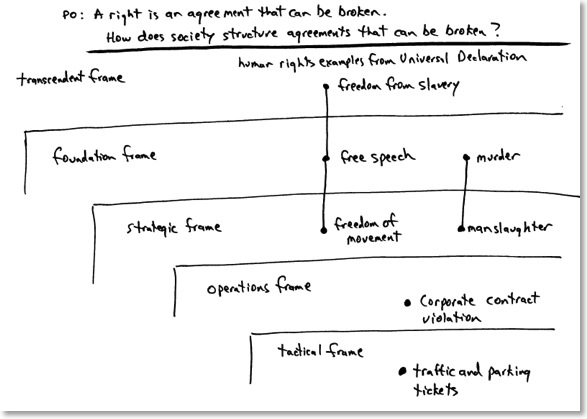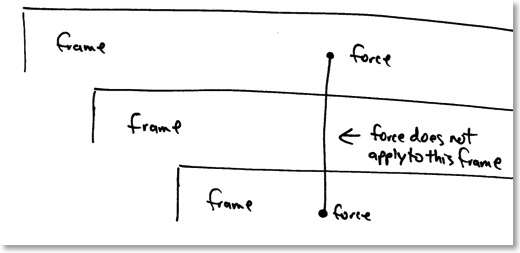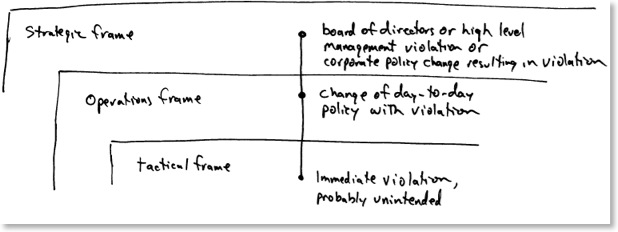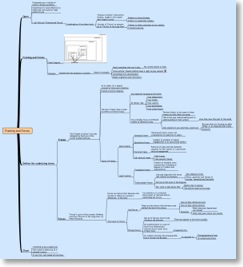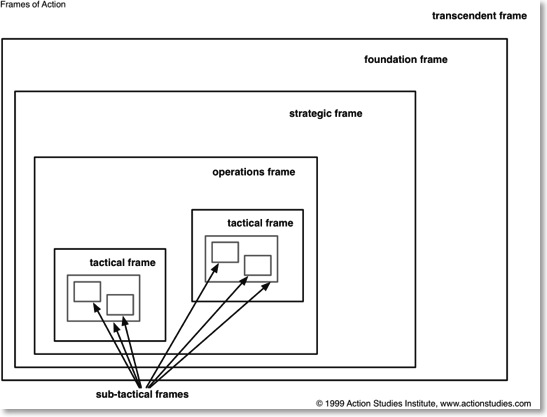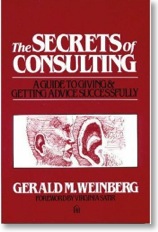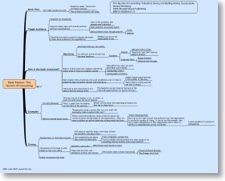Great Mindmapping Reference
I really like the references to Mind mapping bloggers and the references to mindmapping applications and uses. I get these questions a lot and now I can now point to Chuck’s map to help answer them.
He references Dan Roam’s Back of the Napkin book, which I’ve praised before. I also like referring to Joyce Wycoff’s book Mindmapping as well, which I’ve also discussed.
You can click directly to Chuck’s map on his website below.
Great stuff!
Framing and Forces Part 2: Forces
The concept of forces comes from the book “The Art of the Long View” by Peter Schwartz. It’s used for his scenaric thinking technique of strategic planning, but performs well for other purposes.
Schwartz describes forces as “factors that influence the success or failure of a project, endeavour, or decision”. I usually write the project, endeavour, or decision at the top of my diagram to help focus my thoughts. It might be best to show an example for a specific problem and explain it after.
I want to draw a concept from Leadership Calgary that I was working on last year. I was in the human rights learning day and we were given as a starting point a definition of a right as “an agreement that can be broken”. Remember that this is a starting point, because you can see that there are several questions that get raised from this definition. The definition is provisional.
To map out the definition I wanted to draw the forces used in the different types of related agreements, where they apply in society. Specifically I wanted to indicate the frames operating in society that are concerned when one of these agreements is broken. There are all sorts of agreements, but I wanted to draw a few select ones to illustrate my thoughts on the matter. The drawing below is my attempt to illustrate this. (Thanks go to Meg for listening while I drew a different version of this.) You may click the diagram for a larger version.
On a diagram like this I draw forces in a few different ways, depending on what I want to get across. If I know the general position of a force, I will draw it with a dot and label the dot, positioning it in the appropriate frame, like “traffic and parking tickets” in the tactical frame and “corporate contract violation” in the operations frame.
Sometimes a force is broader than a specific frame so you need more than a dot. In this case I use line spanning more than one frame, which indicates a range of effects over multiple frames. An example of this is the human rights examples in the diagram. It’s important to place a dot on the line in each frame that is affected. It’s possible that you might skip frames in between, indicating that that frame is not involved with this force. You draw this using straight line through a frame with no dot in that frame.
The only other technique I apply is I sometimes use an arrow to indicate trends, direction, or desired direction. Sometimes forces move into different frames depending on a shift in perspective or to a shift in the problem at hand. In this case I draw an arrow showing the general direction.
I’ve drawn these by hand to show you that this isn’t supposed to be a fancy drawing technique. Rather much like Dan Roam’s book “The Back of the Napkin”, this is intended to illustrate and to reason through issues, either by yourself or with others. It is useful for chalkboards, paper scraps and napkins. You can certainly draft up a clean version afterwards, but the point in the tool is ease and spontaneity with depth. If I was drawing the “a right is an agreement” diagram on a paper or whiteboard working it through with someone, the discussion would probably go something like the following. You may want to bring up the diagram in a separate window.
If we assume that a right is an agreement that can be broken, how does that relate to other agreements in society? These can be broken as well, but how is a right different from those types of agreements? If we pick an example of a simple, trivial violation, traffic and parking tickets immediately come to mind. In this case the law has been broken, but the crime was probably committed based on a momentary mistake rather than part of a greater plan (thus a tactical decision). In addition, the impact to society isn’t as significant relative to other crimes, so this is an agreement in the form of a broken law at the tactical level.
Next we consider two corporations that do not live up to the contract they wrote between themselves. Corporations tend to be focused on day-to-day operations (getting the job done) and, if they break agreements, will probably break their agreements with one another in this frame (the operations frame). You could make an argument that corporations sometimes make immediate momentary decisions that violate contracts. That would then create a range extending down into the tactical frame. You could also make an argument that on occasion a board of directors might direct their staff to no longer follow a certain contract. This would extend the range up into the strategic frame and so a line would be drawn up to there as well. These are all cases where we have an agreement in the form of a broken contract at one of these three levels.
In the case of killing in society, thereby breaking agreements of right to life and safety, I selected a couple as an example. When a person is convicted of a murder charge, we consider their actions to have been preplanned or otherwise too egregious to lightly forgive. This is a violation of the ability to society as a whole to function properly, so murder exists at the foundation frame. We use the crime of manslaughter for times where there are extenuating circumstances and the intent behind the crime is less clear. I placed this in the strategic level (as I was thinking of defence lawyers operating strategically for their clients), but it might also be more properly placed in the operations frame, indicating that the crime was committed as something was being done, rather than with strategic intent (which then might be murder). You can see how other forms of killing in society might apply. “Crimes of passion”, self-defence, or crimes of temporary insanity might be in the tactical frame, even though the impact to society is greater. I’m not going to discuss the topic of euthanasia, but if you think about it for a bit you can see that it clearly sits in the transcendent and foundation frames, because of the effect it has on society and humankind as a whole. How we handle that topic defines a key portion of who we are and how we as humanity define ourselves.
By now you should also see that this isn’t a tool for judging right or wrong. Rather, it’s a tool for judging range of effect, range of importance and provides a vocabulary for thinking about difficult, not understood, or hard-to-pin-down topics.
In the case of human rights, I selected three from the UN Universal Declaration of Human Rights. This functions as a useful mechanism for analysing in which frames the document is written. Freedom from slavery covers all of humankind and is part of the essence of how we define ourselves as a species. As such, it resides in the transcendent frame. Free speech is defined to varying extents from one culture to another. That is, the support of it or the suppression of it to a greater or lesser extent tends to be defined culturally. Thus, Free Speech resides in the foundation frame. Freedom of movement (to leave your nation and re-enter it) is quite variable from one country to the next, one government to the next, and changes based on complex combination of informal agreements, treaties and other factors. This then indicates that freedom of movement is operating at the strategic level.
So you can see that the definition of a right as an agreement that can be broken is useful for analysis purposes. We can do the following with this diagram:
Analyse the varying degrees of rights that the Universal Declaration defines:
- relative to each other
- relative to their importance in humankind
- relative to how likely they are to be broken, and who might be likely to break them
Analyse agreements of other sorts:
- relative to their severity in society
- an indication of their impact to society and how violations should be punished
- as a tool to evaluate “creeping rights” like a “right to a parking spot” and show them for the false importance that they are (this is clearly a tactical frame issue)
This posting is turning out to be a bit longer than I’d intended, so I will delay my second example, something from the business world, for a third posting.
At this point it may occur to you that a concept like forces really isn’t necessary to use the frames tool. To some certain extent that’s true. I find however that using the forces concept focuses my thoughts directly on what is influencing the topic I want to study. Before I added the forces technique to the frames tool I found that my thoughts were less focused and what I was drawing wandered around a bit. That can be helpful when you want less precision, but can get in the way when you want to think things through clearly. Your application of forces will ultimately lie in how much you want to focus at any particular time. It’s a simple thing, but important to keep in mind.
You may like to see the mindmap that was used to write the draft of this series of entries. Please click on the map below for a bigger picture.
Framing and Forces Part 1: Frames
The tool I have in mind is what I call my “Framing and Forces” tool. This tool is a combination of two other tools, which I’ve found to work well together. The first is the “Frames of Action” map taught in Leadership Calgary and the second is the concept of “Forces” as described the book “The Art of the Long View”, which I’ve talked about before.
This posting will talk about the Frames of Action and a second posting will talk about forces.
Frames of Action was designed by Ken Low from the Action Studies Institute. It is used as part of the Leadership Calgary curriculum (and used here with permission from Ken).
The term “Frame” refers to a particular level of focus. The diagram is built to keep your attention on several different levels of focus. We often pay attention to only one or two different levels and even then inconsistently and at different times. This tool helps you to be aware of what frames you and others are using. The concept of frames drives your understanding towards how you see others acting and how they see themselves acting. It also explains what they (or you) cannot see because they (or you) are focusing on other things, or on an inappropriate frame for the problem at hand.
You can use this tool to think about your own frames: your family, department, country, government, school board, or any other organization. It’s very versatile.
Below is a blank diagram of all the frames. Click for a larger version.
The frames are broken down into several different types. Not all of them are worthy of your attention at any particular time. That depends on the situation. The frames that most people are familiar with are the following (in order from general to more specific):
- Strategic Frame - This frame deals with planning the strategy that is needed. Here you set up your plans for deploying your solution or approach. As with the name, this frame deals with overall strategy.
- Operations Frame - This frame deals with the creation of common patterns that you use to implement your strategies (“the doing of the strategies” ). Often this is where processes are created, or simply things you regularly do in order to get the job done or problem solved. It might include training, logistics, ways of doing things, hierarchical roles and responsibility. As with the name, this frame deals with the doing of day-to-day operations.
- Tactical Frame - This frame deals with the steps needed in order to accomplish a specific goal. The term “tactic” is used here to refer to something specific, like a specific project or goal. This could be winning a certain objective, delivering a certain product, and so on.
- Sub-Tactical Frame - Below tactical frames are any number of sub-tactical frames, which are used to accomplish tasks for the greater tactical goal. These can be smaller tasks of any sort. It’s often not useful to list them unless they are in some way creating problems at a higher frame.
I think an example might be helpful. A company has overall goals to make money in a certain market segment, defined by their strategies (Strategic Frame). They decide that they need two different divisions “A” and “B” in order to achieve this, so they create those divisions. Each of these divisions has some common Operations Frames (because they work in the same company) but some independent ones as well. Other divisions like Finance, Legal and Human Resources have their own Operations Frames, though also share some with A and B.
You can probably see how this diagram can be used to show conflict. For example, if divisions A and B are in competition with one another for some reason (like bonuses for completed jobs from corporate), they might not be inclined to cooperate with each other. In adversarial companies they might even be “forbidden” to talk to each other or be physically separated to discourage communication. These are examples where divisions are operating in two different conflicting tactical frames, or even two completely opposed operations frames. This is usually not healthy for a company, but it is sometimes done with “startup” divisions that are isolated away from the main company in order to do some unique work. This may or may not be good for a company, but that is another discussion.
There are two other frames that are less well known but are just as important.
- Foundation Frame - Above the strategic frame, this frame talks about the “story” of “what we’re all about”. It describes communities that an organization resides within and how it relates to those communities. These communities both allow and limit freedoms, provide opportunity for responsibilities and specify obligations. A computer company works with several foundation frames, such as what they do (and do not do) relative to other companies and competitors, the physical communities they exist within, including laws, culture, their employees and ways of doing business. A religious organization or charity also operates within many such frames. In fact, we all do as contributors to and people who benefit from society. Many ethics policies in companies, specified as partly strategic frame and operations frame documents, are written to abide within principles at the foundation frame level.
- Transcendent Frame - Above the foundation frame, this frame is the “story” of our connection with existence and life. Despite the title, “transcendent” does not imply any religious or mystical connotation, though many religions do make strong connections with the transcendent frame. When we talk about essential wisdom, philosophy or experience from the past, this falls within the transcendent frame. Some environmental groups talk of protecting the planet for ourselves or for the future. They are describing a transcendent frame that promotes the continued existence of all life on the planet. An example of a company that directly connects their work to the transcendent frame is Ray Anderson’s Interface Inc, which plans to make the company 100% sustainable, and is actively working towards that difficult goal.
You often will not use all frames when drawing a Frames and Forces diagram, but it doesn’t hurt to at least list them on the diagram to jog your memory to see if they are involved in the problem you are trying to solve.
The next posting in this series will talk about Forces and provide an example.
You may like to see the mindmap that was used to write the draft of this series of entries. Please click on the map below for a bigger picture.
Book Review: The Secrets of Consulting
I don’t think that the book is named correctly. It would be better titled “The Secrets of Problem Solving”. That’s a more accurate title, but it’s boring and probably wouldn’t sell as many books. I can see many consultants reading this book due to the original title. However, I believe that the target audience is for anyone that needs do overall problem solving in organizations (which is everyone, isn’t it?).
Weinberg assumes that most problems in organizations aren’t primarily technical ones. Rather, most problems are people-based and exist or continue to exist through people’s actions or inactions. If you ignore the people the problem won’t get fixed. Makes sense to me.
The book is broken down into several chapters describing major categories of problem solving. Chapter titles like “Being effective when you don’t know what you’re doing”, “Seeing what’s there”, and “Seeing what’s not there” give you a good idea of the content. Each chapter covers problems by telling a humorous story. It then gives a set of rules or guidelines that the author learned from that story.
For me these guidelines are the best part of the book. It’s difficult to find a book that has good distilled knowledge. A reader usually has to read many books and can pull a gem or two out of each one. This book is filled with them, and you don’t have to do as much work because they’ve been generalized for you already. There are other books I know of that do this well, for example “Metaphors We Live By” and “Simplicity”. In the computer field I can also think of design patterns and refactoring principles. Books like this are rare, though.
I also like how the book is structured so you can easily pick it up and put it down. Each guideline is broken up into a separate mini-section and they are all listed at the back of the book with page references. This makes the book very easy to use as a tool, rather than something you read once and put up on a shelf to dust.
Here’s a couple of examples: “The Why Whammy” and “Marvin’s Second Great Secret”.
“The Why Whammy” says “We may run out of energy, or air, or water, or food, but we’ll never run out of reasons.” There is a lot in this one sentence. Apply this guideline when you are trying to figure out “why” a problem is occurring. While it is true that asking the question “why” is very useful for obtaining facts, Weinberg states that it does not give you the underlying principles that led to these facts. Due to The Why Whammy you can be asking “why” forever and continue to get more facts without getting you closer to a solution. Weinberg is not stating that you should not ask “why”, rather that you should do it judiciously and not assume that it in and of itself will solve your problem.
A second guideline I like is “Marvin’s Second Great Secret” which states "Repeatedly curing a system that can cure itself will eventually create a system that can't." So before interfering with problems, think a little bit about the overall problem solving health of the organization. After all, many problems are solved in an organization already otherwise nothing would get done (that’s related to “Rudy’s Rutabaga Rule”, which I won’t cover). Weinberg is reminding us to avoid going in and meddling in problems that the organization is perfectly capable of fixing. If you do so often enough, then you create a dependency in that organization and it loses it's ability to independently correct a problem. Many executives would do well to understand this guideline.
Many of the guidelines in this book are great and I think I will need to read the book a few times to learn and apply them properly. I can immediately see where many of them apply, from diagnosing an existing problem and preventing problems from occurring in the first place.
The humour in this book makes it even more appealing. Guidelines can be dry and thus difficult to learn and remember. These ones are told with simple funny stories, which greatly increases their appeal. After all, who wouldn’t want to know more about “Brown’s Brilliant Bequest” or “The Orange Juice Test”?
I highly recommend this book to anyone who wants to add general problem solving skills to their toolbox.
The Secrets of Consulting: A Guide to Giving and Getting Advice Successfully
Gerald Weinberg
1985, Dorset House Publishing
ISBN 0-932633-01-3
You may like to see the mindmap that was used to write the draft of this entry. Please click on the map below for a bigger picture.
Writing on The Back of the Napkin
Well, that’s not quite right. It’s actually about drawing pictures on anything (paper, whiteboards, the back of your hand if you must). This book is aimed for primarily at business people, who aren’t necessarily known for great drawings, favouring “chartware” instead.
“The Back of the Napkin”, by Dan Roam, argues that we spend too much time making charts that people don’t understand. When we make diagrams they are generally not as useful as they should be. Much of what we write isn’t read because much of it is presented in a way that we are not suited to understand. As a person who works for a multinational, multiethnic company, where much of the team does not share the same language, I know that words can cause problems. Also, adding more of them to clarify isn’t always the best solution. I often feel that if I could just draw a picture in the right way I might have a better chance of getting my idea across.
This is just the kind of problem The Back of the Napkin was written for. Roam proposes that all problems and ideas can be broken down into a few unique approaches. From those approaches you can use a straightforward system he calls the “Visual Thinking Codex” in order to select the type of information you want to convey. Better yet, you only need a few simple boxes and lines to pull it off. The author believes that it would be much better if you drew it rather than prepared elaborate charts. This is not to say that elaborate charts don’t have their place. Rather, they are overused and often prevent clarity.
As I was reading the book, I found that much of it wasn’t a surprise. For example, If you want to express “when” information, you use a timeline. I’ve been drawing Gantt charts for most of my career, so this wasn’t a revelation. Or if you want to show “how” you use a flowchart. Again, nothing new.
I noticed something interesting on the way to the last page, however.
The point behind all this wasn’t necessarily to tell you something new. The point was to frame the problem of drawing diagrams into a specific way of thinking about the diagrams. I could see over time that the Codex created by Roam became very useful to frame your thoughts about a particular diagram, based on the information you wanted to convey. Sometimes my thinking is sloppy in this area and I use a diagram that isn’t suited to the problem at hand. Then I have to spend far too much time explaining what I just misdrew.
With the Codex I can think about what to convey in advance and have pointers to what I should be drawing. Very helpful.
I’m sure others may get other things out of this book. I don’t need to be convinced to draw a diagram and I will readily take pen in hand and go at it. (That makes me a “Black Pen” person in the book.) Others need to be convinced of the power of diagrams, or that “they can’t draw” isn’t an issue because these are simple drawings to make.
All in all, I quite liked the book and have already started using it in my daily work.
As an interesting side note, I’ve noticed that I now start categorizing diagrams that I see in the newspaper based on the Codex. Sometimes they match and sometimes they don’t. The ones that don’t match make me look at them to see if they are really displaying information properly. So, the book has also provided me with an interesting diagnostic technique.




